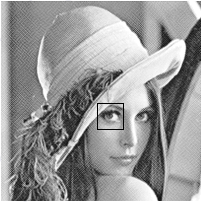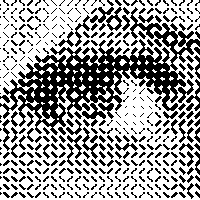 |
One day in 1988 I was sitting in the cafeteria at Xerox PARC, eating lunch and reading a book I had ordered through the PARC library - Jacques Vallée's Messengers of Deception: UFO Contacts and Cults. At that time I was working in PARC's Electronic Document Lab on the problem of perceptually correct digital color printing - something we all take for granted now, in these latter days of cheap color inkjet printers. I had spent much of the preceeding five years, on and off, thinking about printing; halftoning algorithms, Floyd-Steinberg error diffusion, inks, toners, the use of spectroradiometers, and human color perception. The team I worked with had a lab that was painted spectrally flat gray with a reflectance of 11%, and special daylight fluorescent lamps that simulated high quality sunlight - "The Gray Lab".
As I sat there reading two scientists were sitting next to me at the table, excitedly discussing the possibilities of "hypering" documents back to computer files. One of them exclaimed "...and we can put a bar code on the bottom of every page that points back to the electronic document!!!" This utterance penetrated through my study of the book, and stirred me from my dogmatic slumbers - I had studied the history of printing and typography; I had designed digital type; I cared deeply about the appearance and elegance of documents... so I looked up and blurted "THAT would be FUGLY!" I was thinking, you see, about the Universal Product Code barcodes - which are large, and quite visually intrusive.
Suddenly an idea flashed. It was simple, and elegant - conventional halftoning is based on little dots - which were usually ellipses of various sizes, oriented at a 45 degree angle (a subtlety based on the visual cortex's distribution of angle detectors... angled ellipses are less perceptually intrusive - except to certain African tribes that grow up in rounded architectures rather than Western Cartesian architected buildings). Digital halftoning aped analog halftoning, which was based on optical screens of repeated patterns - and all the little elliptical dots in a picture, such as a newspaper picture, always leaned in the same direction. My insight was under computer control this did not have to be true; you could make the little dot lean left to represent a zero, and to the right to represent a one - and that this would be essentially perceptially invisible. You could put computer data into a picture, hidden from conscious view. This sort of hidden data in pictures is called "steganography".
 |
|---|
| Basic data Glyph pattern |
At the time, every document printed at PARC had a title page, with two squares of decorative mid-gray halftone on the bottom. I quickly calulated that rather than the paltry tens of bits that a UPC barcode could put in the same area that my scheme could put kilobits. And still look the same quiet gray, to the eye.
 |
|---|
| Halftone DataGlyph of "Lenna" |
So I wrote the idea up, and submitted an invention disclosure. Shortly after, I came up with a variant idea. Current practice was to stop making improvements on printers and scanners when the dots or shade variations were too small for the human eye to see the difference; this was based on what was called"Just Noticeable Difference". If we went just a little bit farther than JNDs, we could embed data in the variations of color or intensity that would be invisible. So I filed that idea, too. Both ideas ended up filing as patents; the second one didn't issue - but a whole "descent tree" of ideas and patents flowed from the first - and I got my name of several as co-inventor as I and others fleshed out the idea and made it practical - putting in such details as binary morphology image conditioning, image scaling and skewing using Fourier, Walsh, or Harr transforms, error correction, and more.
 |
|---|
| Zeros and ones, embedded in Lenna's eye as left-right rotations |
At the time, the muscian and performer Prince was having contract problems with his label. They owned his stage name, and forbade him to use it. So he made a symbol for himself, and the lawyers called it "Glyph" - and he was denoted in the legal papers as "the artist formerly known as Prince". I was amused by his story, and as a type designer, I liked the word "glyph". So when we were collectively looking for a name for the technology, I proposed "Glyph". The marketeers later changed this to"'DataGlyph".
DataGlyph is a real product, and you can license it from Xerox. I kinda like that :-)
Patents:
Tow, R. "Methods and Means for Embedding Machine Readable Digital Data in Halftone Images" - U.S. Patent no. 5,315,098, May 1994. This is the basic "Smart Paper" (TM) / Glyph (TM) patent)
The following patents describe the technology - a degenerate case of the Halftone case above - used in Glyph (TM), as incorporated in Xerox's Paperworks(TM).
Bloomberg, D., Tow, R. - "Adaptive Scaling for Decoding Spatially Periodic Self-clocking Glyph Shape Codes" - U.S. Patent no. 5,091,966, February 1992. This was the first "Smart Paper" (TM) patent to issue.
Bloomberg, D., Hect, D., Flores, P., Tow, R. - "Self-clocking Glyph Shape Codes " - U.S. Patent no. 6076738, June, 2000